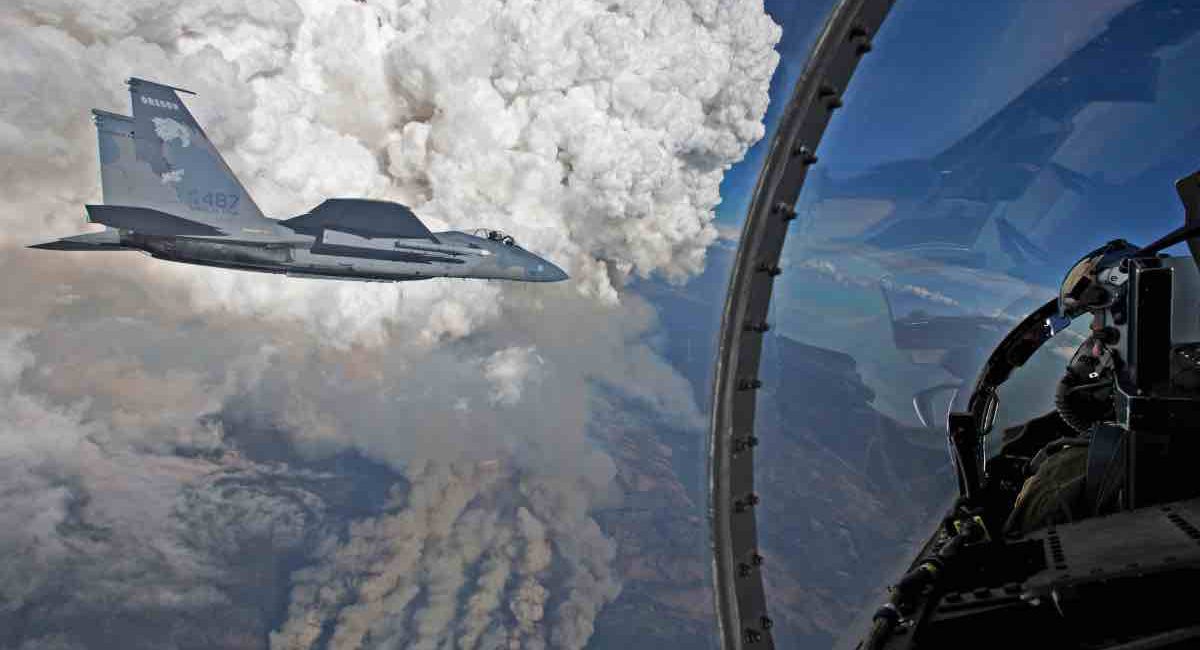Beautiful Footage From The Inside Of An F-15 Cockpit

First delivered in 1972, the F-15 Eagle is the quintessential U.S. Air Force fighter jet. It’s air superiority reputation is unparalleled. This twin-engine, one-seat (F-15A,C) or two-seat (F-15B,D,E) fighter earns its reputation with advanced avionics, supreme maneuverability and acceleration, weapons and range. The Air Force believes the F-15 out-performs any current enemy fighter jet in the world.
Capabilities
High thrust-to-weight ratio combined with low wing-loading (the ratio of aircraft weight to its wing area) give the F-15 its signature maneuverability. The F-15’s avionics suite contains a head-up display, advanced radar, inertial navigation system, flight instruments, ultrahigh frequency communications, tactical navigation system and instrument landing system – among other features. Multiple armament options give the F-15 flexibility depending on its mission. Air-to-air weapons include: AIM-120 advanced medium range air-to-air missiles on its lower fuselage corners, AIM-9L/M Sidewinder or AIM-120 missiles on two pylons under the wings, and an internal 20mm Gatling gun in the right wing root.

The versatility of this fighter combined with its continual avionics updates place the onus of success on what happens inside the cockpit. Whether its a solo pilot in the A and C variants, or a tag-team in the B,D, or E variants, the crew of the F-15 must focus on a lot of factors. Because the F-15 is an air-to-air machine, the cockpit is orchestrated around the Head-Up Display (HUD) which provides advanced information gathered from the planes various avionics. The instruments, switches and indicators are designed around the HUD.
F-15 Cockpit Layout
Here are 21 of the most important cockpit instruments in the F-15 Eagle.
- Multi-Purpose Color Display (MPCD) – lives in the lower left portion of the instrument panel. The MPCD displays the number of external fuel tanks, current state of weapons, and countermeasures.
- IAS and Mach Meter – lives to the right of MPCD. It shows the indicated airspeed and the Mach number.
- Vertical Situation Display (VSD) – or “radar scope” lives in the upper left corner of the instrument panel. It displays the air situation in front of the aircraft, detailing information on other aircraft detected by the radar.
- Attitude Director Indicator (ADI) – lives in the central portion of the instrument panel. The rotating sphere shows the current pitch and bank angles.
- Vertical Velocity Indicator (VVI) – indicates the vertical aircraft speed (the climb and sink rate) in thousands feet per minute.
- Altimeter – Lives to the right of the ADI and shows the barometric pressure altitude and is displayed in units of 20 feet.
- Fan turbine inlet temperature indicators (FTIT) – lives below the tachometer. The indicator scale graduates each 100 degrees Celsius. The indicator arrow in the red zone shows dangerously high turbine gas temperature.
- Engine Tachometers – indicate engine RPM. They show percentages of the maximum RPM, and a red zone corresponds to the “afterburner” zones.
- TEWS Display Unit – lives in the upper right corner of the instrument panel. It displays info on radars illuminating the F-15. The information is presented as symbols that indicate radar type and direction, also self-protected jammer activity.
- Fuel quantity indicator – measures how much fuel is available in both internal and external tanks. Fuel amount is measured in pounds.
- Chaff and flare lights
- Landing gear control handle
- Landing gear position indicator
- Angle of Attack (AoA) indicator – lives on the instrument panel under the IAS and Mach meter. It indicates the current AoA value within the limits of 0 to 45 units. The AoA indicated values do not correspond to actual degrees.
- Accelerometer – shows the current values of positive and negative G loads.
- Horizontal Situation Indicator (HSI) – lives in the lower center of the instrument panel. The HSI shows a top-down view of the aircraft superimposed on a compass. The aircraft’s heading always appears at the top of the display. The course arrow, on the outer edge of the display, shows the direction of the next waypoint.
- Clock
- Engine fuel flow indicators – measure and show the current values of the fuel flow for each engine. Fuel flow is measured in pounds per hour.
- Engine exhaust nozzle position indicator – lives in the lower left corner of the instrument panel. The two indicators show the nozzle position (opening rate) of each engine in percents from the fully opened position. In afterburner mode, the nozzles are fully opened.
- Cabin pressure altimeter – shows the altitude at which atmospheric pressure is equal to the current cockpit pressure.
- Caution lights panel
F-15 Cockpit Video
As you see in the video below, the F-15 looks like one smooth ride. But it’s not as easy as these accomplished pilots make it look. Between the massive amount of knowledge necessary to understand this aging aircraft and the guts it takes to fly missions in it – F-15 pilots are truly an impressive bunch.
Modernization efforts to F-15 Eagle’s all across the country as well as several other nations continue to take place. The fighter jet will continue to serve well past 2025 and even as long as 2050 by some estimates. Since the F-22 and F-35 are designed to take out the enemy long before it reaches visual range, the F-15 is one of the last legitimate dogfighting options left for the U.S. Air Force.
We think you’ll love these images of fighter aircraft cockpits!

